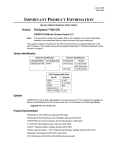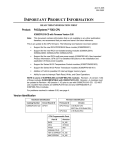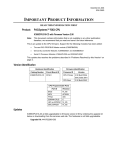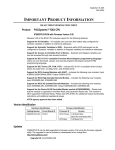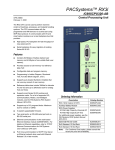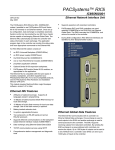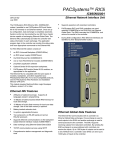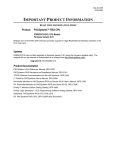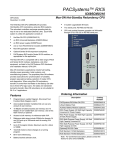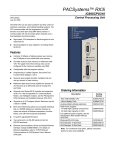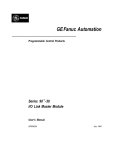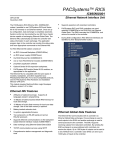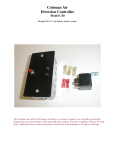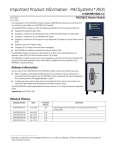Download PACSystems RX3i CPUs, IC695CPU310
Transcript
June 24, 2004
GFK-2329
IMPORTANT PRODUCT INFORMATION
READ THIS INFORMATION FIRST
Product:
PACSystems™ RX3i CPU with Firmware Version 2.50
IC695CPU310-AA
This document contains information that is not available in any other publication; therefore,
we recommend that you read and save it for future reference.
This is the initial release of the RX3i CPU310.
Version Identification
Hardware Identification
Catalog Number
IC695CPU310-AA
Firmware Identification
Circuit Board ID
Firmware ID
Version
CP4A1
CPU Primary
2.50 Build 26A4
BOC Build 24A1
CPU Boot
2.50 Build 25A3
CPU Programmable Parts
Part ID
Revision
BIOS
f4_r05
MCU
f4_r05
FPGA
X05
SDRAM CPLD
C
HW rev EPROM
f4_r05
Product Documentation
PACSystems CPU Reference Manual, GFK-2222
PACSystems RX3i Hardware and Installation Manual, GFK-2314
TCP/IP Ethernet Communications for the PACSystems, GFK-2224
C Toolkit for PACSystems User’s Manual, GFK-2259
CIMPLICITY® Machine Edition Getting Started, GFK-1868
Logic Developer – PLC Programming Software Getting Started, GFK-1918
Datasheet, PACSystems RX3i CPU, GFK-2316
IPI, PACSystems RX3i CPU, GFK-2329 (this document)
Important Product Information
2
GFK-2329
CPU Functional Compatibility
Subject
Description
Programmer
Version
Requirements
CIMPLICITY® Machine Edition Logic Developer 5.0 or later must be used to configure and program
the RX3i.
C Toolkit
Compatibility
The C Toolkit for PACSystems is distributed with CIMPLICITY® Machine Edition Logic Developer
5.0 or greater. Toolkit build 50A1 or later is required for use with the RX3i. Please note: The
Series 90 Toolkit (IC641SWP709/719) is not compatible with PACSystems.
Series 90-30
Module
Compatibility
The PACSystems RX3i supports the following Series 90-30 modules:
Discrete Input Modules: IC693ACC300,
IC693MDL230/231/240/241/632/634/645/646/648/654/655
Discrete Output Modules:
IC693MDL310/330/340/390/730/731/732/733/734/740/741/742/748/752/753/760/930/931/940
Discrete Combinational: IC693MAR590, IC693MDR390
Analog I/O Modules: IC693ALG220/221/222/223/390/391/392/442
High Speed Counter: IC693APU300
FANUC I/O Link: IC693BEM320, IC693BEM321
Motion Control: IC693DSM314
All other Series 90-30 modules are not currently supported.
IC694 (blue)
Module
Compatibility
The PACSystems RX3i supports the following IC694 modules:
IC694ACC300, IC694MDL230/231/240/241/632/634/645/646/654/655
Discrete Output Modules:
IC694MDL310/330/340/390/732/734/740/741/742/752/753/930/931/940
Analog I/O Modules: IC694ALG220/221/222/223/390/391/392/442
High Speed Counter: IC694APU300
Motion Control: IC694DSM314
Expansion Backplanes: IC694CHS392/398
Expansion Power Supplies: IC694PWR321/330/331
Series 90-30
Expansion
Rack
Compatibility
The PACSystems RX3i supports local and remote Series 90-30 expansion racks.
PACSystems RX3i CPUs do not operate in a Series 90-30 Rack.
Series 90-30
Main Rack
Compatibility
Series 90-30 Main Racks cannot be used in a PACSystems RX3i system.
Series 90-30 CPUs do not operate in PACSystemsRX3i Racks.
Isolated 24V
power
In applications that use the IC69xALG220/221/222, consult PACSystems RX3i Hardware and
Installation Manual, GFK-2314 for details of wiring the 24V power.
Important Product Information
GFK-2329
New CPU Features and Enhancements
Release 2.50 of the RX3i CPU provides the following new features and enhancements compared to the family of
Series 90-30 CPUs:
■
■
■
■
Non-volatile flash (10Mbyte) and battery-backed user memory (up to 10 Mbytes).
■
■
■
■
■
Support for new Rx3i modules, as well as Series 90-30 discrete and analog I/O, and High Speed Counter.
■
■
CPU over temperature status bit.
A new register/WORD reference table (%W) that is configurable up to 4Mbytes.
Auto-located Symbolic Variables that can use any amount of user memory.
Larger reference table sizes, which include 32 Kbits for discrete %I and %Q and up to 32K words each for analog
%AI and %AQ.
Application compatibility with PACSystems RX7i applications.
Up to 512 program blocks. Maximum size for a block is 128KB.
Online Edit and Test modes that allow editing and testing of logic changes that are permitted for a Run Mode Store.
Bit-in-word referencing that allows you to specify individual bits in a WORD reference in retentive memory as inputs
and outputs of Boolean expressions, function blocks, and calls that accept bit parameters.
Two serial ports: one RS-485 serial port and one RS-232 serial port – neither are isolated.
3
Important Product Information
4
GFK-2329
CPU Restrictions and Open Issues
Subject
Description
Ethernet
Disconnect
During Word for
Word Change
If the Ethernet connection is broken during a word-for-word change, the programmer may not
allow a subsequent word-for-word change after reconnecting due to the fact that it thinks
another programmer is currently attached. If this occurs, you should go offline and then back
online again.
Simultaneous
Clears, Loads and
Stores Not
Supported
Currently, PACSystems CPUs do not support multiple programmers changing CPU contents at
the same time. The programming software may generate an error during the operation.
Power Cycle
During Online Edit
If the user stores a folder to flash that is configured to power up from flash and then
subsequently power is cycled in the middle of a Online Edit session, the programmer will still
indicate that the Online Edit session is in progress after the power cycle. The user should
cancel the Online Edit session to continue.
Power Cycle
During Write to
Flash
If the CPU is power cycled during the process of writing to flash, and is configured to power up
from flash, a fault will be generated on power up.
Hardware
Configuration Not
Equal After
Changing Target
Name
If the user stores a hardware configuration to flash which indicates that “Logic/Config Power up
Source” is set to “Always Flash” or “Conditional Flash” and then subsequently changes the
name of the target in the programming software, the hardware configuration will go Not Equal
and will not Verify as equal.
PLC and IO Fault
Tables May Need
to be Cleared
Twice to Clear
Faulted State
Both PLC and IO fault tables may need to be cleared to take the CPU out of Stop/Fault mode. If
one of the tables contains a recurring fault, the order in which the tables is cleared may be
significant. If the CPU is still in Stop/Fault mode after both tables are cleared, try clearing the
fault tables again.
Setting Force
On/Off by Storing
Initial Value
Once a force on or force off has been stored to the PLC, the user cannot switch from force on
to force off or vice-versa directly by downloading initial values. The user can turn off the force
by doing a download, and then change the force on or off by another download.
Storing Large
Numbers of
Blocks to Flash
Currently, storing logic with approximately 200 blocks or more to flash may fail, due to the
programmer timing out.
Number of Active
Programs
Returned as Zero
The SNP request Return Controller Type and ID currently returns the number of active
programs as zero.
Over Sweep
Condition in
Constant Sweep
Mode
When the PLC is configured for Constant Sweep mode, a consistent over sweep condition can
cause the programmer to lose communications with the PLC. The user must insure that when
Constant Sweep mode is configured, sufficient buffer is allowed for communications to occur
with the programmer.
Serial I/O Failure
at 115K During
Heavy Interrupt
Load
Rare data corruption errors have been seen on serial communications when running at 115K
under heavy interrupt load on the PLC. Under heavy load applications, users should restrict
serial communications to 57K or lower.
RAND_MAX and
rand() Function
Incompatible
In the C Toolkit, the RAND_MAX system variable is defined as a 32-bit integer. However, the
rand() function returns a 16-bit integer. By definition, rand() should return an integer between 0
and RAND_MAX.
Firmware Update
Attempt to
Incorrect Module
If an attempt to load Ethernet module firmware is inadvertently directed to a slot containing a
different type of module (for example, an analog module) WinLoader will fail with the error
"Target is unable to enter boot mode. Serial communications error: Request timed out". After
this error occurs, the CPU will be in an invalid state and should be power cycled.
Incorrect
Commreq Status
For Invalid
Program Name
The program name for PACSystems is always "LDPROG1". When another program name is
used in a CommReq accessing %L memory, an Invalid Block Name (05D5) error is generated.
Important Product Information
5
GFK-2329
Subject
Description
Second
programmer can
change logic
while in Test &
Edit mode
While currently active in a Test and Edit session using CIMPLICITY Machine Edition on one
PC, CIMPLICITY Machine Edition running on another PC is not prevented from storing new
logic to the PLC.
FANUC I/O Master
and Slave
operation
Scan sets on the master do not work properly for the first operation of the scan set after
entering RUN mode. They do work properly for subsequent scans.
After downloading a new hardware configuration and logic, a power cycle may be required to
resume FANUC I/O operation.
Use PLCs of similar performance in FANUC I/O networks. If a master or slave is located in an
RX3i system, the other PLCs should be RX3is or Series 90-30 CPU374s.
Must Have Logic
If Powering-Up
From Flash
If the application will configure the CPU to retrieve the contents of flash memory at power-up,
be sure to include logic along with hardware configuration when saving to flash memory.
Avoid Ethernet
module resets
Resetting the Ethernet module, either by Service Request 24 or by the restart pushbutton, will
cause some of the CPU’s internal memory to be consumed if EGD is configured. The problem
becomes more pronounced with larger EGD configurations. Power-cycling the system will
recover the internal memory.
Service Request
24 results in
different fault
messages
When Service Request 24 is used to reset a module in the RX3i system, a Reset of I/O Module
fault appears in the PLC fault table. For RX7i systems, two faults appear: Reset of I/O Module
and Loss of I/O Module.
Configuration
mismatch with
unsupported
module causes
PLC sequence
store failure
If you attempt to store a hardware configuration to the CPU that has a module configured for a
slot that physically contains an unsupported module, the store will fail with a sequence store
failure.
Overtemp
thresholds are too
low
The CPU has two thresholds for operating temperature: normal and critical. These thresholds
are intended to be set at 58ºC and 63ºC respectively, but the current thresholds are 55ºC and
60ºC. These thresholds are determined under worst case thermal operating conditions (minimal
air flow with hot modules on either side of the CPU).
When the operating temperature of the CPU exceeds the normal operating temperature, the
system variable #OVR_TMP (%SA8) turns ON. (To turn it OFF, clear the PLC fault table or
reset the PLC.) This fault (fault group 0x18, error code 0x0001) is configurable to be diagnostic
or fatal (default configuration is for diagnostic).
A second overtemp threshold will cause a fatal error (fault group 0x0D, error code 0x00A8)
when the CPU has exceeded the critical temperature point just prior to hardware failure.
Conditions for
Changing Sweep
Mode
In PACSystems, users can change sweep mode parameters while the CPU is running only if
they have previously stored logic (stop mode, Run Mode store, or word-for-word change) during
the current connection. Performing a Test/Edit operation removes the ability to change sweep
mode parameters, until another store of logic (stop mode, RMS, or WFW change) is done.
Power Supply
Firmware Version
Reported
Incorrectly
The information presented for the power supply in CIMPLICITY Machine Edition’s Device
Information Details window will say "N/A" (not applicable), rather than supply the version
information for the firmware in the power supply.
Important Product Information
6
GFK-2329
CPU Operational Notes
Subject
Slot
numbering,
power supply
placement,
CPU
placement
and reference
Description
1.
2.
3.
4.
5.
The A/C Power-Supply (IC695PSA040) for the RX3i is a doublewide module whose connector
is left justified as viewed when installed in a rack. It cannot be located in Slot 11 of a 12-slot
rack nor Slot 15 of a 16-slot rack. No latch mechanism is provided for the last (right-most) slot in
a rack, therefore it is not possible to place the power-supply in the second to last slot.
The RX3i CPU (IC695CPU310) is a doublewide module whose connector is right justified as
viewed when installed in a rack. It is referenced for configuration and by user logic applications
by the leftmost slot that it occupies. For example, if the RX3i CPU has its physical connector
inserted into slot 4, which means it occupies slots 3 and 4, the CPU is referenced as being
located in slot 3. The referenced location of the CPU is not determined by what slot the physical
connector is located in, but rather by the left most slot occupied by the entire module.
Due to item #2 above, the RX3i CPU may be located in Slot 0 of a rack (physical connector in
Slot 1). In addition the CPU cannot be located in Slot 11 of a 12-slot rack nor Slot 15 of a 16-slot
rack, since doing so would require the physical connector to be located in the slot reserved for
an expansion module.
When migrating a Series 90-30 CPU system to a PACSystems RX3i CPU, be aware that to
maintain the Slot 1 location of the CPU, only a singlewide power-supply may be used in Slot 0.
Currently, the only available singlewide power-supply is a DC power-supply (IC695PSD040).
Therefore, if the application using an existing Series 90-30 system must maintain a Slot 1 CPU
and uses an AC power-supply, the RX3i system must have the RX3i AC power-supply located
in a slot to the right of the RX3i CPU in Slot 1.
In deciding to place the CPU in slots other than Slot 1, the user should be aware of the possible
application migration issues that could arise. The following table lists the areas that could be
affected when migrating an application from one CPU slot to another.
Item Affected
User Logic
How Affected
Service Request #15
(Read Last-Logged Fault
Table Entry)
Service Request #20
(Read Fault Tables)
Location of CPU faults will not be the standard 0.1
location, but will reflect the slot the CPU is located in.
User logic that decodes fault table entries retrieved by
these service requests may need updating.
Communications Request
(Commreq)
Commreqs directed to the CPU (e.g. those directed to the
serial ports of the CPU) will need to be updated with the
correct CPU slot reference.
H/W
Configuration
CPU Slot location
Slot location of the CPU must be updated in the HW
Configuration to reflect the CPU’s true location.
Fault Tables
Faults logged for the CPU
The location of faults logged for the CPU in the fault table
will not be the standard 0.1 (rack.slot) location, but will
reflect the CPU’s actual slot.
External
Devices
Series 90 PLCs
Remote Series 90 PLCs that use SRTP Channels COMMREQs expect the CPU to be in
slot 1. To support communications with Series 90 SRTP clients such as Series 90 PLCs
using SRTP Channels, the RX3i internally redirects incoming SRTP requests destined for
{rack 0, slot 1} to {rack 0, slot 2}, provided that the CPU is located in rack 0 slot 2 (and the
remote client has not issued an SRTP Destination service on the connection to discover
the rack and slot of the CPU). This special redirection permits Series 90-30 applications
that expect the power supply to be located leftmost and the CPU to be located to the right
of the power supply to function. Attempts to establish channels with CPUs in slots other
than 1 or 2 will fail if initiated from Series 90 PLCs.
HMI and External Communication Devices
All external communication devices that interact with the CPU should be checked for
compatibility with CPU slot locations other than slot 1. Problems may arise with, but are
not limited to, initial connection sequences and fault reporting. CIMPLICITY Machine
Edition View customers should select “GE SRTP” as their communications driver – it can
communicate with a CPU in any slot.
Host Communications Toolkit (HCT)
Applications that utilize the Host Communications Toolkit may require updated drivers.
Important Product Information
7
GFK-2329
Subject
Description
Important
Installation
Instructions
for Battery
A battery is shipped with the CPU unit behind the battery door on the faceplate but it is not
connected. Do not connect the battery until the CPU is installed in the rack and the rack powered on.
The battery may then be attached to either of the two terminals in the battery compartment. Once
that is done, the CPU may be powered down and normal battery back up operation will begin. If the
battery is installed before the CPU is powered up, it will drain the battery 10 times faster until power
is applied. To save battery life, do not connect the battery for the first time until the CPU is powered
up.
LD-PLC
operations
Machine Edition LD-PLC does not allow a user to perform operations that change the PLC until
explicitly connecting to the target device. For example, to perform a download to the PLC, you must
first connect to the PLC.
Logic
Executed in
Row Major
Instead of
Column
Major
Logic execution in PACSystems RX3i is performed in row major order (similar to the Series 90-30).
This is different from the Series 90-70, that executes in column major order. This means that some
complicated rungs may execute slightly differently on PACSystems RX3i and Series 90-70. For
specific examples, see the programming software on-line help.
NaN Handled
Differently
Than in 90-30
The PACSystems RX3i CPU may return slightly different values for Not A Number as compared to
Series 90-30 CPUs. In these exception cases (e.g., 0.0/0.0), power flow out of the function block is
identical to Series 90-30 operation and the computed value is still Not A Number.
PID
Algorithm
Improved
The PID algorithm used in PACSystems has been improved and therefore PID will function slightly
differently on PACSystems RX3i than on the Series 90-30. The differences are that the elapsed time
is computed in 100 µS instead of 10 mS units. This smooths the output characteristic, eliminating
periodic adjustments that occurred when the remainder accumulated to 10mS.
Also, previous non-linear behavior when the integral gain is changed from some value to 1
repeat/second was eliminated.
Some Service
Requests
different from
90-30 or no
longer
supported
Service Requests 6, 15, and 23 have slightly different parameters. Refer to GFK-2222.
PACSystems PLCs support Service Request 26/30 functionality via fault locating references.
The first word of a Service Request command block is required to contain a zero. On the Series 9030, this value was ignored. Please note: the parameter to the service request must be the address of
the location containing the zero.
Service Requests 48 and 49 are no longer supported (there is no auto-restart) because most faults
can be configured to be not fatal.
IL and SFC
IL and SFC are not available.
DO I/O
Instruction
The Series 90-30 Enhanced DO I/O instruction is converted to a standard DO I/O instruction (the
ALT parameter is discarded and ignored.)
END
Instruction
The Series 90-30 END instruction is not supported. Alternate programming techniques should be
used.
Non-nested
JUMP,
LABEL, MCR,
& ENDMCR
Instructions
Non-nested JUMPs, LABELs, MCRs, & ENDMCRs are translated to the corresponding nested
JUMPs, LABELs, MCRs, & ENDMCRs when converting from Series 90-30 to PACSystems RX3i.
Changing IP
Address of
Ethernet
Interface
While
Connected
Storing a hardware configuration with a new IP address to the RX3i while connected via Ethernet will
succeed, then immediately disconnect because the RX3i is now using a different IP address than
the Programmer. You must enter a new IP address in the Target Properties in the CME Inspector
window before reconnecting.
Important Product Information
8
GFK-2329
Subject
Description
Duplicate
Station
Address for
Modbus Will
Conflict with
Other Nodes
The default serial protocol for the RX3i is Modbus RTU. The default Station Address is 1. If the PLC
is added to a multi-drop network, care must be taken that the PLC is configured with a unique
Station Address. Nodes with duplicate Station Addresses on the same network will not work
correctly.
Timer
Operation
Care should be taken when timers (ONDTR, TMR, and OFDTR) are used in program blocks that are
NOT called every sweep. The timers accumulate time across calls to the sub-block unless they are
reset. This means that they function like timers operating in a program with a much slower sweep
than the timers in the main program block. For program blocks that are inactive for large periods of
time, the timers should be programmed in such a manner as to account for this catch up feature.
Related to this are timers that are skipped because of the use of the JUMP instruction. Timers that
are skipped will NOT catch up and will therefore not accumulate time in the same manner as if they
were executed every sweep.
Constant
Sweep
Constant Sweep time, when used, should be set at least 10 milliseconds greater than the normal
sweep time to avoid any over-sweep conditions when monitoring or performing on-line changes with
the programmer. Window completion faults will occur if the constant sweep setting is not high
enough.
Large
Number of
COMM_REQs
Sent to
Module in
One Sweep
Causes
Faults
A large number of COMM_REQs (typically greater than 8) sent to a given board in the same sweep
may cause Module Software faults to be logged in the PLC fault table. The fault group is
MOD_OTHR_SOFTWR (16t, 10h) and the error code is COMMREQ_MB_FULL_START (2). When
this occurs, the “FT” output of the function block will also be set. To prevent this situation,
COMM_REQs issued to a given board should be spread across multiple sweeps so that only a
limited number (typically 8 or less) of COMM_REQs are sent to a given board in each sweep. In
addition, the FT output parameter should be checked for errors. If the FT output is set (meaning an
error has been detected), the COMM_REQ could be re-issued by the application logic.
C Block
Standard Math
Functions Do
Not Set errno
In C Blocks, standard math functions (e.g. sqrt, pow, asin, acos) do not set errno to the correct value
and do not return the correct value if an invalid input is provided.
Upgrading
Firmware
The process of upgrading the CPU firmware with the WinLoader utility may fail when multiple IO
modules are in the main rack, due to the time it takes to power cycle the rack system. If the upgrade
process fails, move the CPU to a rack without IO modules and restart the upgrade process.
Winloader initial connect baud rate is fixed at 19200 baud. Note that the firmware download will
occur at 115.2K baud by default.
Note that if you have hyperterm open on a port, and then try to use Winloader on the same port,
Winloader will often say “Waiting for Target” until the hyperterm session is closed.
Hot Swap
Hot Swap of power supplies or CPUs is not supported in this release.
Single Power
Supply
Use only one power supply in an RX3i main rack.








